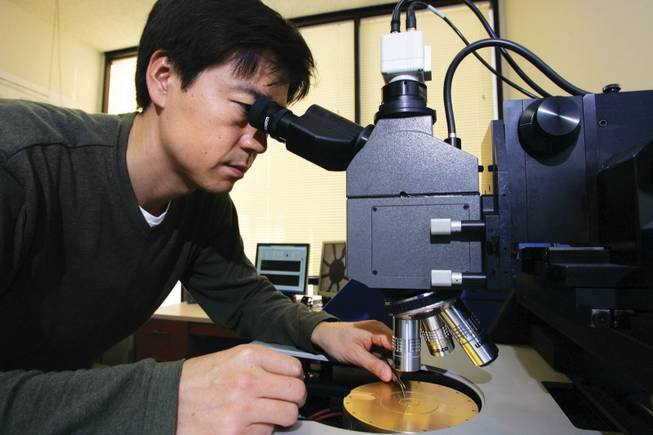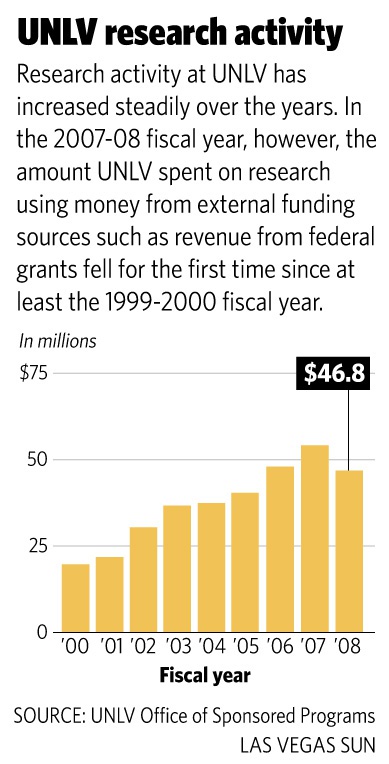
UNLV associate research professor Joon Soo Lee looks through a laboratory microscope in November 2007. The university recently had its first decrease in research activity in years, and the value of research awards from external sources dropped from $74.8 million in fiscal year 2007 to $39.8 million in fiscal year 2008.
Saturday, Feb. 14, 2009 | 2 a.m.
Growth has long defined UNLV. Over the past decade or so, in a quest to become a nationally recognized research institution, the university expanded its faculty, added dozens of graduate programs and secured increasing numbers of federal research grants.
Sun Archives
- Gov. Gibbons strikes back – with a podcast (2-11-2009)
- Rogers highlights ways universities have saved money (2-9-2009)
- As budget cuts loom, UNLV lacks requested program rankings (2-8-2009)
- Funding inequities have no simple fix (2-6-2009)
- UNLV must scramble to save $25 million gift, hotel building (2-2-2009)
- Administrators says proposed cuts too much to withstand (1-26-2009)
- Research park running through cash, still empty (1-25-2009)
Beyond the Sun
Now, UNLV is slipping backward. Budget cuts are reversing some of the expansion, no shock given the depth of the state’s financial crisis.
More surprising is that one aspect of the slide is unrelated to the economic downturn.
In the fiscal year ending in June 2008, the amount UNLV spent on research using external revenue, such as money from federal grants, dropped to $46.8 million from $54.1 million the previous year. That was the first decrease in research activity since at least fiscal 2000.
The value of new research awards the university received from external sources fell too, plummeting from $74.8 million in fiscal 2007 to $39.8 million in fiscal 2008.
Rochelle Athey, executive director of sponsored programs at UNLV, attributes the declines in large part to a one-year moratorium on most federal research earmarks in fiscal 2007. Because it takes time for these appropriations to reach universities, UNLV did not feel the brunt of the moratorium until the following year.
How could suspending earmarks — derided by opponents as “pork” — put such a dent in UNLV’s research funding? Though research activity at the school, as measured in dollars, has more than doubled since 2000, earmarks still account for the majority of external money the school spends on research. The nation’s top universities reap federal appropriations, too, but the most prestigious ones support their research primarily through federal grants and other awards for which faculty members compete.
When it comes to funding research, “You may not want to depend on having a well-connected member of Congress,” says Kei Koizumi, the American Association for the Advancement of Science’s director of research and development budget and policy program. “It’s certainly more sustainable to have enduring capabilities that are recognized in competitive programs. To put it simply, Sen. (Harry) Reid may not be around forever as majority leader.”
In fiscal 2008, UNLV received $9.6 million in earmarks for sponsored activities, compared with $41 million the previous year. Though research makes up just a portion of sponsored activities — those activities include projects such as cultural conservation studies on public lands, which are not considered research — almost all earmarks the university receives for sponsored activities go to research.
Over the years, this money has helped UNLV build the laboratories and buy the pricey equipment necessary to compete for external funding. A radiochemistry education and research center that earmarks helped establish over the past five years, for instance, has received more than $1 million from industry and sources that require researchers to compete for the funding.
With budget cuts forcing the university to downsize, the return of earmarks does not guarantee that UNLV will be able to resume growing its research capabilities.
“Two or three years ago, it looked like we were really going to go places,” Athey said. “Of course, with the crash in the economy and the declining revenues here due to gaming being down, we’ve had to revise our viewpoint and cut back and find ways we can maintain where we are now.”
To save money, the school has left about 100 faculty positions vacant, about a tenth of the total roster. Because faculty members drive research, applying for grants and mentoring students, those cuts will be a major blow to the university’s research capabilities.
Reductions in the number of staff members available to help professors prepare funding proposals and keep track of research-related expenditures will also set UNLV back. Even before the financial crisis, faculty members complained that the university lacked proper administrative support for researchers.
Losses the university has incurred could snowball. Dan Cook, coordinator of UNLV’s entertainment engineering and design program, says, “Anyone who has a brain is looking for another job. Any untenured faculty member at UNLV who tells you they are not looking for a job is lying.”
Budget cuts are also disrupting the university’s efforts to bring in more non-earmark research money. In fiscal 2008, UNLV devoted about $1.4 million in “seed money” to help faculty members work toward securing competitive funding. Through the President’s Research Awards program, for example, the university distributed a total of $400,000 to help faculty members launch projects that could later win awards from agencies such as the National Science Foundation. The school could not afford to continue the program this year.
To improve new faculty members’ chances of landing competitive funding, UNLV has, in the past, provided them with start-up money for purchasing equipment, paying graduate student researchers and renovating laboratory space. These dollars, now limited, made UNLV attractive to promising young researchers who might have had to wait several years before establishing laboratories at other institutions.
“If this budget crisis had happened five years or more into the future, UNLV may have been on a better footing because the initial investment in research infrastructure ... may have produced increased competitive research funding,” Athey said. “Now, however, UNLV may have to spend long years rebuilding that infrastructure support.”


Join the Discussion:
Check this out for a full explanation of our conversion to the LiveFyre commenting system and instructions on how to sign up for an account.
Full comments policy